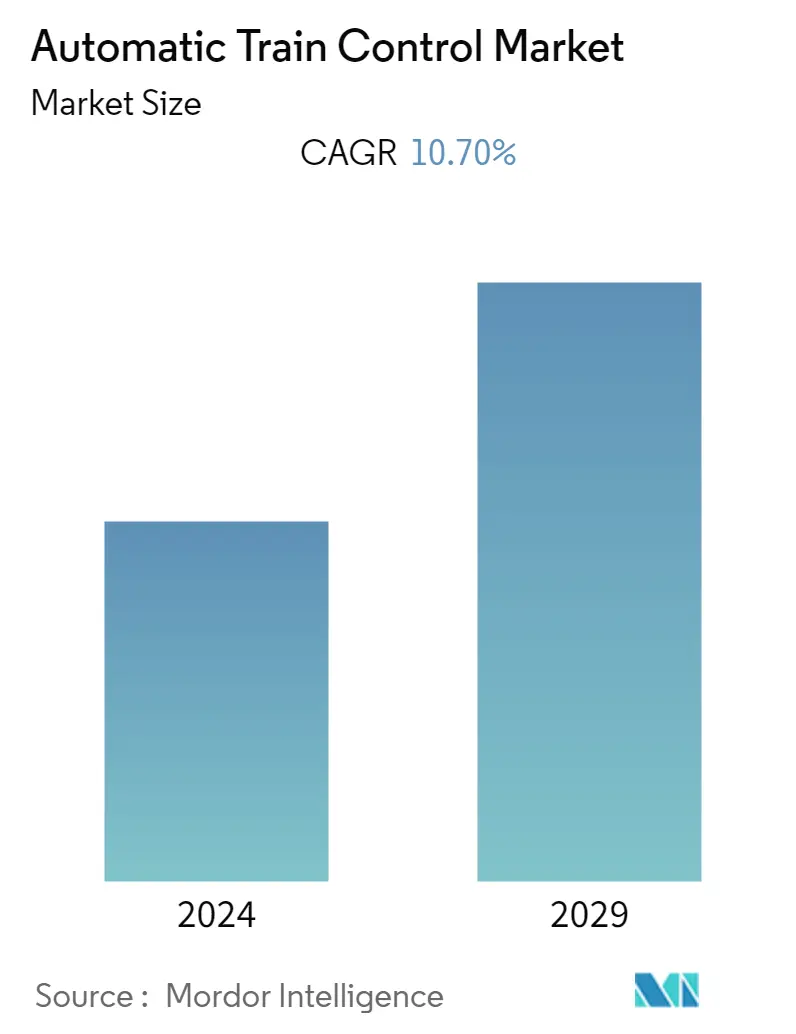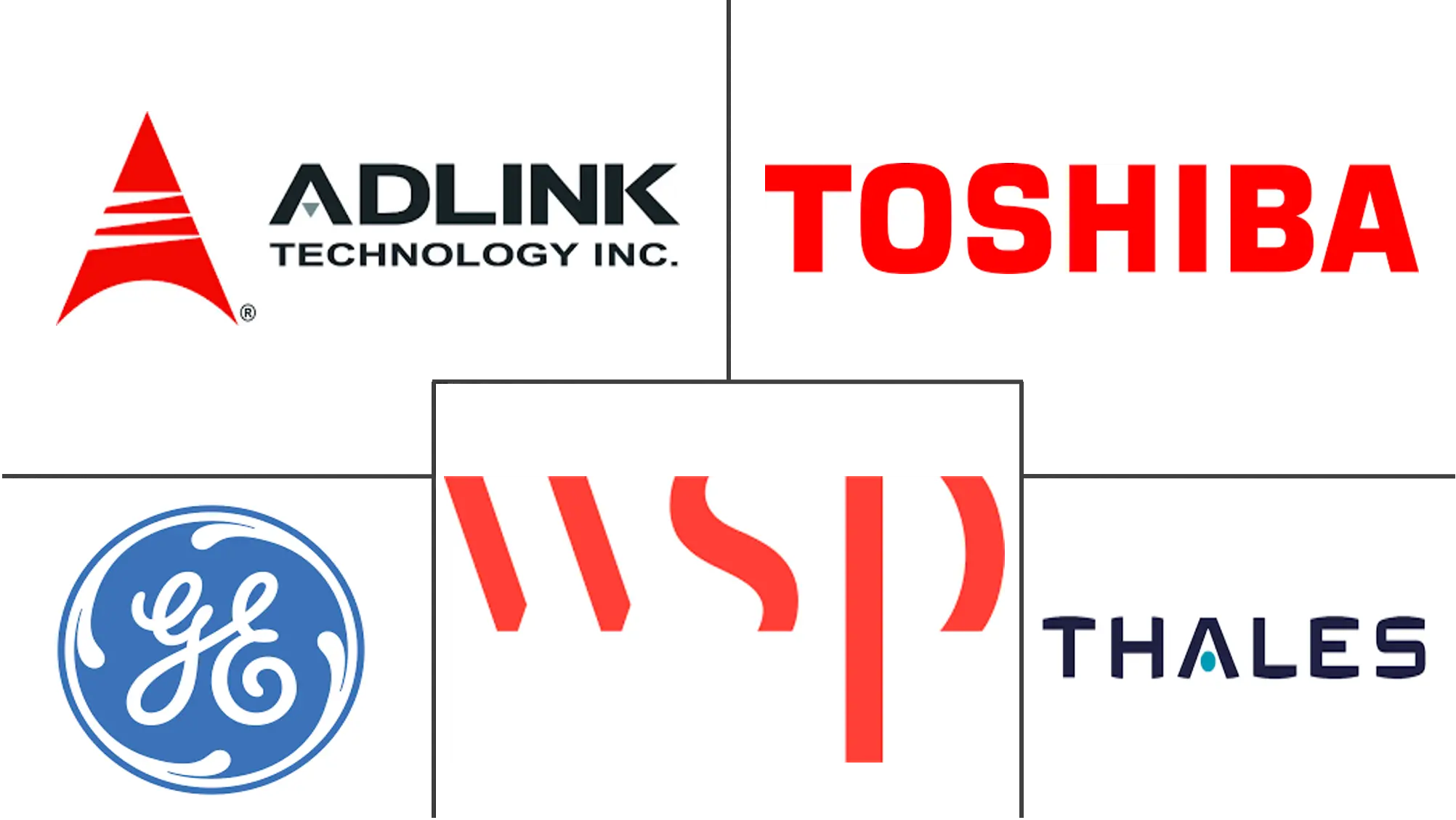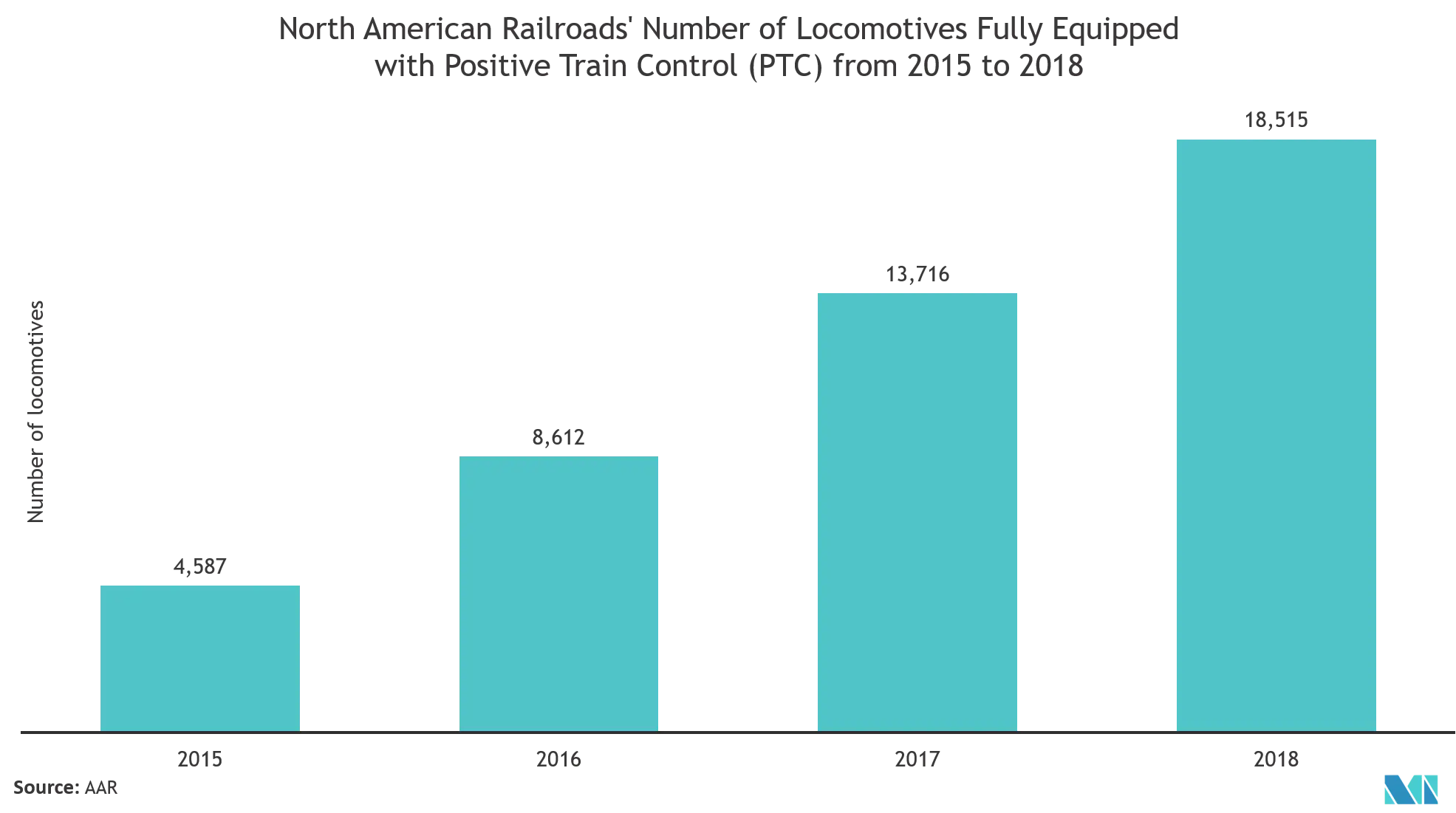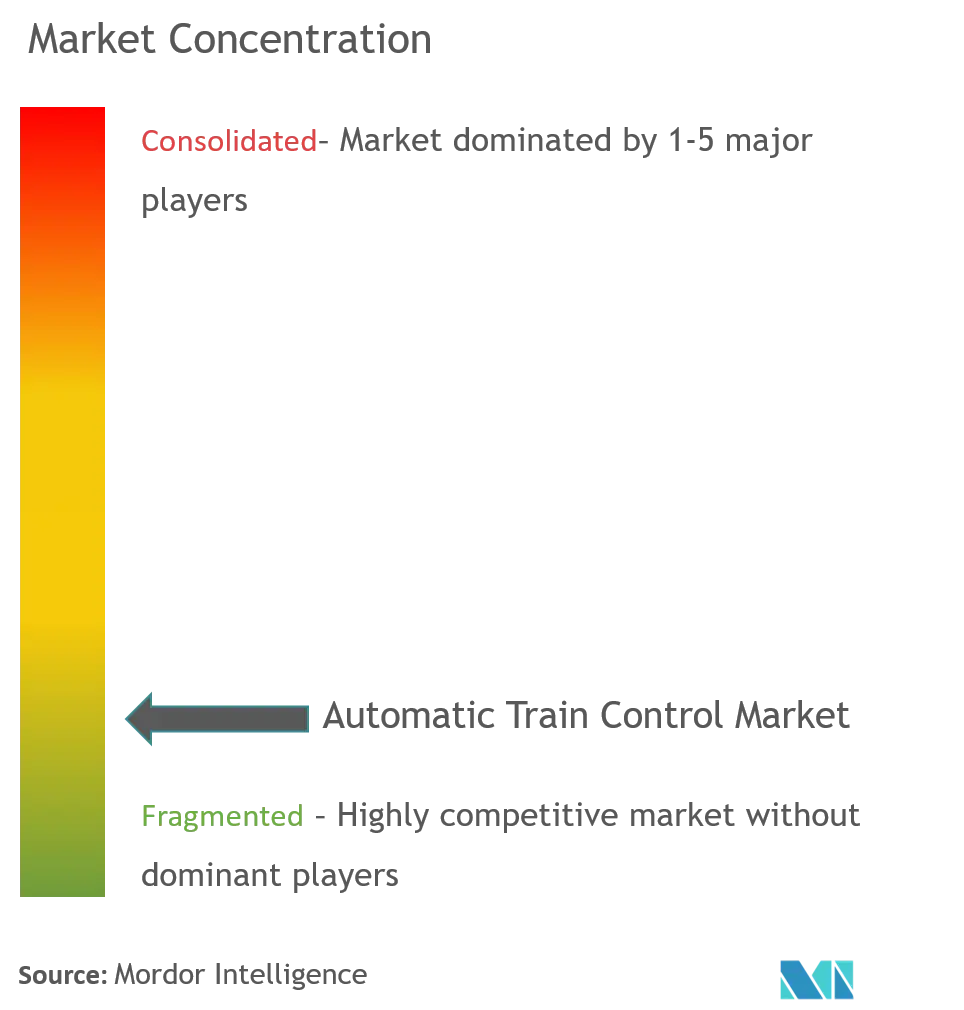Automatic Train Control Market Size

| Study Period | 2019 - 2029 |
| Base Year For Estimation | 2023 |
| CAGR | 10.70 % |
| Fastest Growing Market | Asia Pacific |
| Largest Market | North America |
| Market Concentration | Low |
Major Players
*Disclaimer: Major Players sorted in no particular order |
Automatic Train Control Market Analysis
The Automatic Train Control Market is expected to grow at a CAGR of 10.7% over the forecast period 2020 to 2025. Developing government assistance through providing funds for the building of technologically advanced trains pushes the automatic train control market globally. Furthermore, the increasing demand for pollution mitigation & rising demand for safety, hyper-urbanization, high demographic growth, technological advancements for improving passenger convenience, and increasing trend of smart cities are other fundamental factors propelling the global automatic train control market over the forecast period.
- Support and maintenance segment to expand at a higher growth rate during the forecast period. The support and maintenance services support the installed ATC system within the firm's infrastructure. The support and maintenance services include troubleshooting assistance, problem-solving, repairing, replacing old components, upgradation of the existing ATC solution, and testing scenario management, including facility inspection and training and round-the-clock support for ATC solutions.
- Growing standardization of rail signaling solutions is one of the most significant trends affecting the market today. Standardization enables suppliers to improve core, standards-based global architectures that both allow the interoperability required to meet local safety obligations and give a common, reliable platform for creating local solutions.
- Furthermore, the U.S. Department of Transportation (USDOT) is focusing on expanding rail lines in the Sonoma-Marin Area. For this project, FTA (Freight Transport Association) provided a USD 22.5 Mn fund to the rail ministry. China is projected to create a lucrative opportunity for the ATC market due to a Chinese company signing two rail projects with Brazil, to build two big-ticket railway-related infrastructure projects in eastern Brazil's Bahia state.
- For instance, countries like India, where Metro rail is going to be more than 70% of the railway market according to IBEF, have allowed 100% foreign direct investment in new rail sectors such as suburban corridors, high-speed train systems, and the freight line projects implemented through a public-private partnership.
- The US-based company SIL4 Systems develops onboard embedded control systems for enabling automatic train protection (ATP) and automatic train control (ATC). They offer a dual-purpose platform that houses an event recorder as well as allows for ATP and ATC. Further, they provide a range of vehicle communications such as dual WiFi, GPS, 3G, and dual Gigabit Ethernet (GbE) ports.
- Chinese suppliers are getting projects outside of China, while a group of smaller competitors is competing for pieces of each rail transport project, making for a crowded and competitive field. There is enormous potential for systems that meet the European Rail Traffic Management System (ERTMS) and Communication Based Traffic Control (CBTC) requirements.
- Nevertheless, the high initial investments and the necessity for regular maintenance may restrain the growth of the global automatic train control market in the coming years. However, the rising uptake of autonomous trains in densely populated Asian economies, like China and India, is expected to keep the automatic train control market running smoothly in the forthcoming years.
Automatic Train Control Market Trends
This section covers the major market trends shaping the Automatic Train Control Market according to our research experts:
Positive Train Control (PTC) Technology to Hold a Dominant Share of the Market
- Positive Train Control (PTC) is a composite system of recently developed technologies that continuously delivers critical information such as train movement authorization, speed limits, switch positions, work zone locations, and other operational data. It must factor in locomotive and rail car mix, terrain, weight and speed, and signal aspects to determine safe stopping distances.
- Global freight railroads continue to strive towards an accident-free future through a tireless commitment to addressing the major causes of accidents - track, equipment, and human error. Continued safety improvement in the years ahead will become harder to achieve and require new and different solutions. Widespread deployment of Positive Train Control (PTC), designed to address human error, will open the door to an exciting new era of safety and efficiency improvement for freight railroads.
- For instance, as of January 2020, PTC is in operation on the majority of 98.5% of Class I PTC route-miles network-wide, with some Class I railroads planning to be fully implemented on their networks across the United States, as Track-caused accidents account for 27% of total train accidents in the United States.
- Besides, Freight railroads have reduced the track-caused accident rate by 26% since between 2009 and 2018. Also, record investment has taken place on an average of USD 25 billion each year, where PTC technology has been an important catalyst.
- Providing high scalability and enhanced efficiency, Siemens's Trainguard Sentinel solutions are tailored to meet the needs of industrial, mining, or freight operators optimally. The system allows enhanced service recovery, improved safety, and superior dependability and support forecast.

North America to Hold the Largest Market Size
- North America forms developed economies, the United States (US) and Canada, which contribute heavily to the regional market. One of the principal reasons for its significant market share in the early enactment of technologies and the globalization of shared services in this region.
- In the United States, train accidents caused by equipment represent 14% of total accidents. The equipment-caused accident rate is down 11% since 2009. Enhancements to rail cars, advanced equipment inspection technology, and industry-wide asset management programs have all added to this safety gain.
- This region's strong financial position enables its countries to invest heavily in leading ATC solutions and technologies. The primary growth drivers for this region are the rising number of projects focused on upgrading and constructing freight infrastructures, and high-speed railway lines.
- Additionally, with the Rail Safety Improvement Act of 2008 and the corresponding regulations issued by the Federal Railroad Administration (FRA), passenger and significant freight railroads were required to implement Positive Train Control (PTC) on most major track lines by December 31, 2018. The RSI Act of 2008 has boosted the deployment of ATC solutions and associated technologies in the US, as ATC solutions are at the core of PTC.
- According to the Association of American Rail Roads, accidents caused by human factors form the biggest category of train accidents, accounting for 38%, in addition to the registered 937 rail fatalities in the United States in 2019, according to the US Department of Transportation. The individual factors-caused accident rate is down 3% since 2009. Rigorous employee training and fatigue management programs are just a few of the initiatives railroads apply to decrease these incidents, and PTC provides a backup extra layer of protection to those efforts.
- Also, the region is witnessing massive investments in the Automatic Train Control Market. For instance, according to US Department of Transportation & Federal Railroad Administration, until 2015, 6.4 billion U.S. dollars have been spent for the PTC deployment on over more than 2,300 of track miles and more than 4,500 locomotives, and the total cost is estimated to grow to more than 10 billion U.S. dollars in 2020.

Automatic Train Control Industry Overview
The Automatic Train Control Market is highly fragmented and consists of several major players. They have adopted different strategies such as expansions, agreements, new product launches, joint ventures, acquisitions, partnerships, and others to expand their footprints in this market. Few of the major competitors currently working in the global automatic train control market are General Electric Company (GE), Hitachi, Bombardier, Siemens, Thales, Kyosan Electric Manufacturing Ltd (Kyosan), Toshiba Corporation (Toshiba), Alstom SA (Alstom), Tech Mahindra, WSP, Cisco Systems (Cisco), Mermec, Advantech, Mipro, and ADLINK Technology among others.
- Feb 2020 - Bombardier and Caisse de dépôt et placement du Québec (CDPQ) have signed a memorandum of understanding (MoU) to sell the former's rail business to Alstom in France. Bombardier and Canadian pension fund management company CDPQ will sell their interests in Bombardier Transportation to Alstom. They value the enterprise at USD 8.2bn. CDPQ owns a 30% stake in Bombardier Transportation.
- May 2019 - ADLINK Technology, Inc., released its latest rugged, fanless NVIDIA Quadro embedded AIoT (AI and IoT) platform, the AVA-5500, designed for real-time video/graphics analytics applications in the rail industry. To meet varying application requirements, the AVA-5500 is available in variants featuring an additional two USB 2.0 via M12 connectors and two 2.5" SATA 6Gb/s drive bays, as well as a version supporting +12VDC power input only.
Automatic Train Control Market Leaders
-
ADLINK Technology Inc.
-
WSP Global Inc.
-
Thales Group
-
General Electric Company
-
Toshiba Corporation
*Disclaimer: Major Players sorted in no particular order

Automatic Train Control Market Report - Table of Contents
1. INTRODUCTION
- 1.1 Study Assumptions and Market Definition
- 1.2 Scope of the Study
2. RESEARCH METHODOLOGY
3. EXECUTIVE SUMMARY
4. MARKET DYNAMICS
- 4.1 Market Overview
-
4.2 Market Drivers
- 4.2.1 Increasing Government Support through Providing Funds
- 4.2.2 Intense Demographic Growth and Increased Urbanization
- 4.2.3 Technological Progress Targeted to Passenger Convenience
-
4.3 Market Restraints
- 4.3.1 Necessity for Regular Maintenance
- 4.3.2 Complexities in Integrating ATC Solutions With Legacy Systems
-
4.4 Industry Attractiveness - Porter's Five Forces Analysis
- 4.4.1 Bargaining Power of Suppliers
- 4.4.2 Bargaining Power of Consumers
- 4.4.3 Threat of New Entrants
- 4.4.4 Threat of Substitutes
- 4.4.5 Intensity of Competitive Rivalry
- 4.5 Industry Value Chain Analysis
- 4.6 Assessment of Impact of Covid-19 on the Industry
5. MARKET SEGMENTATION**
-
5.1 By Service
- 5.1.1 Consulting
- 5.1.2 Integration & Deployment
- 5.1.3 Support & Maintenance
-
5.2 By Technology
- 5.2.1 Positive Train Control (PTC)
- 5.2.2 Communication Based Train Control (CBTC)
- 5.2.3 Automatic Train Control (ATC)
- 5.2.4 Other Technologies
-
5.3 Geography
- 5.3.1 North America
- 5.3.2 Europe
- 5.3.3 Asia-Pacific
- 5.3.4 Latin America
- 5.3.5 Middle East & Africa
6. COMPETITIVE LANDSCAPE
-
6.1 Company Profiles*
- 6.1.1 ADLINK Technology Inc.
- 6.1.2 WSP Global Inc.
- 6.1.3 Toshiba Corporation
- 6.1.4 Thales Group
- 6.1.5 General Electric Company
- 6.1.6 Siemens AG
- 6.1.7 MIPRO Electronics Co., Ltd.
- 6.1.8 Tech Mahindra Limited
- 6.1.9 MERMEC Inc.
- 6.1.10 Hitachi, Ltd.
- 6.1.11 Cisco Systems, Inc.
- 6.1.12 Alstom SA
- 6.1.13 Kyosan Electric Manufacturing Co., Ltd.
- 6.1.14 Bombardier Inc.
- 6.1.15 Advantech Co., Ltd.
7. INVESTMENT ANALYSIS
8. MARKET OPPORTUNITIES AND FUTURE TRENDS
** Subject To AvailablityAutomatic Train Control Industry Segmentation
Automatic train control (ATC) is a general category of train protection systems for railways that includes a speed control mechanism in reply to external inputs. ATC systems tend to combine multiple cab signaling technologies, and they use more granular deceleration patterns instead of the inflexible stops met with the older automatic train stop technology. ATC can also be applied with automatic train operation (ATO) and is usually deemed the safety-critical part of the system.
The International Association of Public Transport (UITP) Grades of Automation (GoA) system defines the degree of automation according to the level of responsibility assigned to the train control system. The report also includes;
- Automatic Train Protection (ATP) is the operation and all equipment accountable for basic safety; it avoids red signal overrunning, collisions, and beating speed limits by using brakes automatically. A line provided with ATP corresponds (at least) to a GoA1.
- Automatic Train Operation (ATO) assures incomplete or complete automatic train piloting and driverless functionalities. The ATO system displays all the functions of the driver, besides for door closing. The driver only necessitates closing the doors, and if the direction is clear, the train will automatically move to the next station. This corresponds to a GoA2.
- Automatic Train Control (ATC) works automatically normal signaller services such as route setting and train control. The ATO and the ATC systems collectively manage a train within a defined threshold of its timetable. There is no driver, and no staff designated to guide the train, corresponding to a GoA4.
- At Grade of Automation 4, ATC systems work within an overall signaling system with interlocking, automatic train supervision, track vacancy detection, and communication functions.
| By Service | Consulting |
| Integration & Deployment | |
| Support & Maintenance | |
| By Technology | Positive Train Control (PTC) |
| Communication Based Train Control (CBTC) | |
| Automatic Train Control (ATC) | |
| Other Technologies | |
| Geography | North America |
| Europe | |
| Asia-Pacific | |
| Latin America | |
| Middle East & Africa |
Automatic Train Control Market Research FAQs
What is the current Automatic Train Control Market size?
The Automatic Train Control Market is projected to register a CAGR of 10.70% during the forecast period (2024-2029)
Who are the key players in Automatic Train Control Market?
ADLINK Technology Inc., WSP Global Inc., Thales Group, General Electric Company and Toshiba Corporation are the major companies operating in the Automatic Train Control Market.
Which is the fastest growing region in Automatic Train Control Market?
Asia Pacific is estimated to grow at the highest CAGR over the forecast period (2024-2029).
Which region has the biggest share in Automatic Train Control Market?
In 2024, the North America accounts for the largest market share in Automatic Train Control Market.
What years does this Automatic Train Control Market cover?
The report covers the Automatic Train Control Market historical market size for years: 2019, 2020, 2021, 2022 and 2023. The report also forecasts the Automatic Train Control Market size for years: 2024, 2025, 2026, 2027, 2028 and 2029.
Automatic Train Control Industry Report
Statistics for the 2024 Automatic Train Control market share, size and revenue growth rate, created by Mordor Intelligence™ Industry Reports. Automatic Train Control analysis includes a market forecast outlook to 2029 and historical overview. Get a sample of this industry analysis as a free report PDF download.



